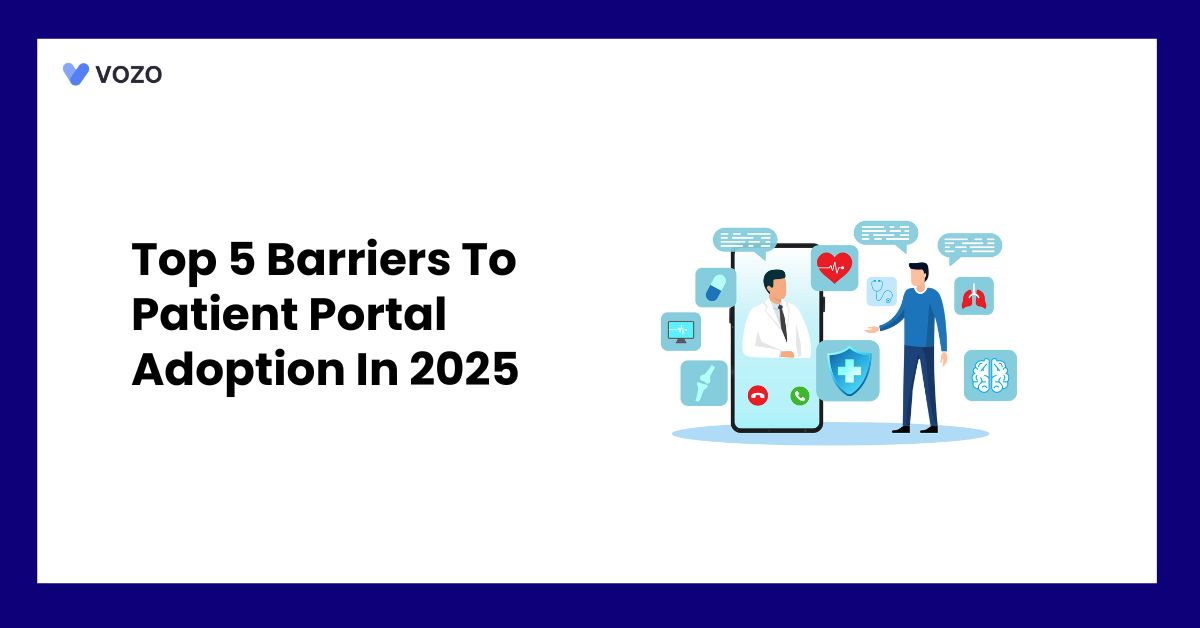Top 5 Barriers To Patient Portal Adoption In 2025
In 2025, despite broad implementation by health systems, patient portal acceptance continues to lag. Just over half of insured persons said they have visited a portal, and around two-thirds said they had ever been given one. Beyond individual preferences and abilities, issues regarding privacy and data security have been recognized as major barriers to portal use in recent evaluations.
Language limitations also prevent involvement; patients with poor English proficiency frequently have trouble comprehending portal interfaces and related messages.
Understanding Patient Portals in Healthcare
Patient portals provide various services, including access to patient medical information, secure messaging with providers, and in some cases, the ability to conduct administrative tasks such as appointment scheduling, billing, and payments. Providers have noticed the benefits and almost invariably provide access to the technology.
Providers must understand the constraints that prevent their patients from adopting and utilizing patient portals. After identifying these limitations, physicians can develop strategies to overcome them and improve patient uptake of the tool. Ideally, this will result in increased patient engagement.
Related: The Ultimate Patient Portal Checklist: What Every Healthcare Practice Needs
5 Barriers to Adopting the Patient Portal
1. Lack of Digital and Health Literacy
Patient Literacy is important to access technology, and internet connectivity can be difficult for elderly people, patients with low income, or lack knowledge in handling systems. Patients may face struggles while registering on online platforms or accessing their information.
Health literacy is the ability to understand medical terms or information, which may affect the patients’ use of portals. This hinders them from communicating effectively with their healthcare providers through patient portals. In 2022, 60 percent of adults nationally reported being given and having visited their portal at least once, although many used it only occasionally, demonstrating that access does not correlate to meaningful usage.
2. Patient Preference
Nearly half, 49% of patients, offered a portal report that they simply do not see a personal benefit in using one, especially when routine care feels efficient via calls or office visits. Many patients still prefer in-hospital visits so that they can have a face-to-face conversation with their providers and discuss their health conditions.
They can clarify their doubts and share sensitive information, and build trust. 64% of non-adopters prefer to speak directly with a provider as their main reason for not using a portal.
3. Privacy and Security Concerns
Patients are concerned about their privacy and security when using digital health tools. They fear that their data might be exposed or misused, leading people to not register in patient portals. Instant access to test data might cause anxiety if patients receive bad news without context from their practitioner.
Studies show patients’ concerns about learning bad outcomes indirectly through the portal. According to a Deloitte report, 58% of customers are concerned about device or platform security, while only 34% believe corporations are transparent about their data usage.
4. Difficult to Navigate
Patients may struggle to navigate some portals due to medical terms and user interfaces. Usability tests show that people are frustrated because of layout issues, confusing terminology, and processing difficulties. Portals provide too much information on a single page, including appointments, messaging, lab reports, and educational resources.
5. Limited Usage for Patient Portal
In a Paubox poll, 57% of patients claimed they didn’t require a portal since they were satisfied with calling or speaking directly with their clinician. Many patients are unaware of the portal’s features, such as medication refill requests, appointment scheduling, lab test results, and encrypted communications.
If people don’t comprehend what the portal can perform, they assume it’s unnecessary. Although 60 percent of those who provided a portal used it at least once in 2022, fewer than 10 percent accessed it six or more times a year, showing that initial sign-up does not always convert into continued involvement.
Related: 5 Effective Ways to Encourage Patients to Use a Patient Portal
Vozo Patient Portal Solution
VOZO patient portal software provides a comprehensive solution to help healthcare providers achieve clinical, financial, and operational excellence through a powerful patient portal.
Our exceptional Patient Portal Software will allow:
- Have complete access to patients’ medical records digitally
- Our cost-effective subscription plan helps healthcare practices at all levels.
- The Vozo patient portal can effortlessly be integrated and implemented with any EHR system to increase productivity.
- Vozo’s Patient Portal respects users’ privacy and safeguards health-related records and personal information.
- 24/7 availability to support you with your needs and requirements.
- By understanding your unique needs for your specialty healthcare practice, we will customize Vozo’s patient portal for a seamless workflow.
Patients can request appointments, access health records and lab results, and even pay bills online with the help of a patient portal, which creates a personal touch with you always.
Leverage the Vozo Patient Portal for Better Healthcare Solutions.
About the author

With more than 4 years of experience in the dynamic healthcare technology landscape, Sid specializes in crafting compelling content on topics including EHR/EMR, patient portals, healthcare automation, remote patient monitoring, and health information exchange. His expertise lies in translating cutting-edge innovations and intricate topics into engaging narratives that resonate with diverse audiences.













